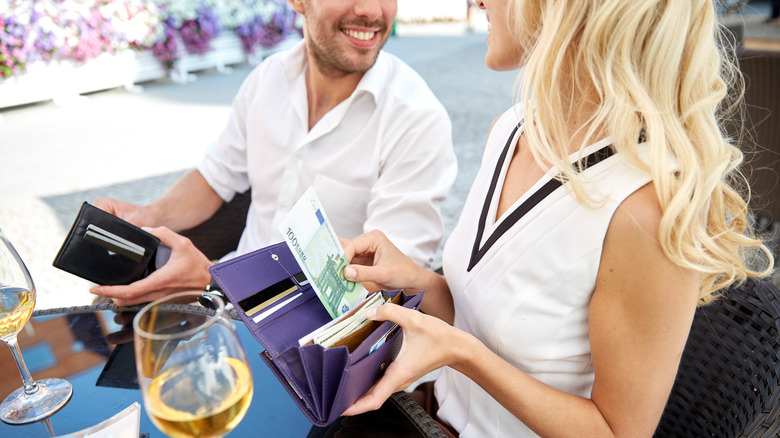Tourists May Want To Avoid Trying This Common Way To Pay While At A Restaurant In Italy
You've just shared a delightful meal of pizza, tiramisu, and wine at a trattoria in Italy with your travel partners, and now comes time to pay. A few of you drank the wine, others tried the tiramisu, but everyone had a slice of pizza! How do you go about that? When dining out in a foreign country, it's essential to be aware of local customs to ensure a smooth experience. While splitting the bill is a routine part of dining culture in many other countries, it can actually lead to confusion and even an unwelcome experience in Italian restaurants. This all has to do with the social conventions in the country.
Italian dining culture places a significant emphasis on the social and communal aspects of eating. Meals are seen as an opportunity to share time, conversation, and food with loved ones. This extends to the way the bill is handled. Traditionally, the bill, or il conto, is paid for by one person, who may collect money from others later. In a family dining situation, the eldest person or the patriarch usually covers the bill. This is quite different from the "split the bill" approach common in many other countries. In North America, it's standard practice to "go Dutch" and pay specifically for what one ate and ordered. This is also common in the Netherlands and Germany.
Why splitting the bill can be problematic in Italy
In many Italian restaurants, servers, managers, or owners usually expect that one person will handle the payment. When tourists ask to split the bill, especially in complicated ways, it is considered time-consuming for the staff. An example would be to split the tiramisu between two bills, divide the pizza cost among the diners, and place the wine on only one person's bill. During peak hours, Italian restaurants get busy, and the additional time required to divide the bill among multiple diners — especially with language barriers in the mix — can be inconvenient. Remember, tipping is not part of the dining culture in Italy; while that doesn't detract from the quality of food service you'll receive, the Italian style of serving is very hands off.
When customers ask for mixed forms of payment, this becomes even more cumbersome, leading to less-than-enthusiastic reception from the waitstaff. The local currency in cash is usually preferred, but card payments are becoming very widely accepted — so long as one payment method is used per bill. Restaurants in tourist-heavy areas or bigger Italian cities may have the technology to handle split bills; however, this is not always the case in smaller or more traditional establishments, as they may still be doing handwritten checks and calculations. If you insist, though, ask for "conti seperati" (separate checks) and confirm if it's allowed before ordering. Be prepared to explain to the waiter what will go on each "conto" and keep it simple.
Alternatives to splitting the bill
One common practice among Italians is for individuals to take turns paying the bill. If you dine out with the same group for several meals — which may likely be the case if you're traveling with a group of friends or family — one person pays for the entire meal each time, and the responsibility rotates. This approach helps simplify the payment process, and also aligns with the communal spirit of dining in Italy. Another effective method is to have everyone contribute their share in cash before the bill arrives. This way, one diner can pay the bill in full using the pooled cash. It's straightforward, avoids complications for waitstaff, and allows everyone to contribute their fair share.
Payment apps, like Splitwise or Venmo, can be another convenient solution for keeping track of group expenditures. While one person covers the entire bill directly with the restaurant, these apps help everyone else in the group to immediately reimburse their share of the "split bill" electronically. But more importantly, regardless of the approach you end up taking, to avoid any surprises or misunderstandings (both within your group and with the server), you must discuss how the bill will be handled before ordering. Agreeing on a method of payment in advance ensures that everyone is on the same page, and it'll streamline the process when it's time to pay. That way, you will be ready when "il conto" comes to the table.


